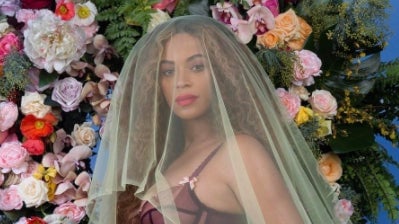Beyoncé’s pregnancy announcement was the coded political act we needed to kick off Black History Month
“Beyoncé is pregnant with twins.” The announcement rocketed around the world earlier this week after the superstar shared a portrait of herself kneeling in verdant greenery, enveloped by an opulent floral arrangement, on Instagram. The colors pop against Beyoncé’s skin—a blue background and the pale green, sheer veil that covers her head. Both hands lovingly hold her bare and obviously pregnant belly as she stares defiantly into the camera lens. The caption of the photo relays the happy news that the Carter “family will be growing by two.”


“Beyoncé is pregnant with twins.” The announcement rocketed around the world earlier this week after the superstar shared a portrait of herself kneeling in verdant greenery, enveloped by an opulent floral arrangement, on Instagram. The colors pop against Beyoncé’s skin—a blue background and the pale green, sheer veil that covers her head. Both hands lovingly hold her bare and obviously pregnant belly as she stares defiantly into the camera lens. The caption of the photo relays the happy news that the Carter “family will be growing by two.”
The image itself, with its lush saturated colors and floral abundance, blends elements of a classic Madonna portraiture (Mary, not Ciccone) with the work of New York-based painter Kehinde Wiley, whose work “raise[s] questions about race, gender, and the politics of representation by portraying contemporary African American men and women using the conventions of traditional European portraiture.” The Biblical connection was clear enough that even the New York Post picked up on it.
In drawing on and extending that work, Beyoncé and the photographer, L.A.-based artist Awol Erizku, have created something much more than a viral celebrity photo shoot. Make no mistake, this is yet another salvo in Beyoncé’s fight to de-center whiteness. And in the process, she turned her pregnancy announcement into a deeply subversive political act.
The timing couldn’t have been better. February 1st marks the beginning of Black History Month in the US, a celebration already marred by a White House Press Briefing in which US president Donald Trump inadvertently revealed that he has absolutely no coherent idea who Frederick Douglass was. Amidst a constant barrage of depressing updates, Beyoncé’s announcement was a welcome break from the white supremacy of Trump’s administration. She snatched the news cycle away from him like a mother restricting her misbehaving child, undermining conservative whiteness in a manner befitting the queen of pop.
Like Wiley and Erizku (whose artistic approach is quite similar to Wiley’s, but more focused on multimedia), Beyoncé’s black feminist aesthetic serves to disrupt racist and sexist historical narratives. From an art history perspective, Beyoncé’s positioning evokes traditional portraiture and iconography of the Madonna through the pose, veil, flower arrangements, and even the blue background—a color often associated with the mother of Christ. In the West, Mary is most often depicted as white, though that would have been geographically unlikely if not impossible. The superimposing of a pregnant black female body in place of the traditionally white religious icon forces viewers to confront and displace whiteness as a presupposed universal—religiously, culturally, and socially.
Subverting Madonna iconography in her work isn’t new for Beyoncé. The beginning of the video for “Mine,” off 2013’s BEYONCÉ, also found Beyoncé styled after Mary, then referencing Michelangelo’s La Pieta. This ultimate mother-child relationship was also used to highlight and critique conceptual themes of racial and sexual “ownership.” By labeling people “yours” and “mine” throughout the video, Beyoncé exposes the notion that ownership in any relationship is based on power. We would do well to reject what’s “yours” and “mine” and instead burn down the whole concept in favor of collectivity.
This week’s news, however, follows a full year of progressively subversive artistic statements designed to make conservative white middle America uncomfortable. February 2016 gave us the surprise release of “Formation”—a video rife with intersectional race, gender, and sexual commentary and a blistering live performance at Super Bowl 50 that referenced the Black Panther Party. Then came the HBO premiere of Lemonade and later, the CMA Awards performance of “Daddy Lessons” with the Dixie Chicks.
The backlash and controversy that followed these incidents clearly and consistently exposed the racist underbelly of America—the same racist underbelly (always present but often hiding) exposed by Donald Trump’s ascendancy to the presidency. As with all Beyoncé’s public and business moves, they were calculated and meticulous. Her music, her performances, her public statements are always meant to speak to larger social issues and dynamics.
Her “Formation” Super Bowl performance simultaneously de-centered and exposed white power in a sport where mostly white team owners make massive money largely off the work of black men. At the CMAs, Beyoncé de-centered the whiteness of country and rock music, exposing how genres that were created with and by black artists have come to be associated solely with white people. And Lemonade itself tells the story of black women’s experience in America.
In this context, we cannot view her pregnancy photo as simply a photo. Statues and representations of the Black Madonna have long been associated with miracles in orthodox Christianity. And God knows we all need a miracle right now. If, in this new age of Muslim bans, shriveling human rights, and a disavowal of reproductive choices, we forget about the violent “yours” and “mine” and instead focus on “ours” and “we,” we just might have a chance to counter Trump’s violent American vision.
Perhaps Beyoncé is also letting us know she’s with us. A miracle is possible. It’s time, once again, to get in formation. Because ultimately, she’s not the miracle. We are.